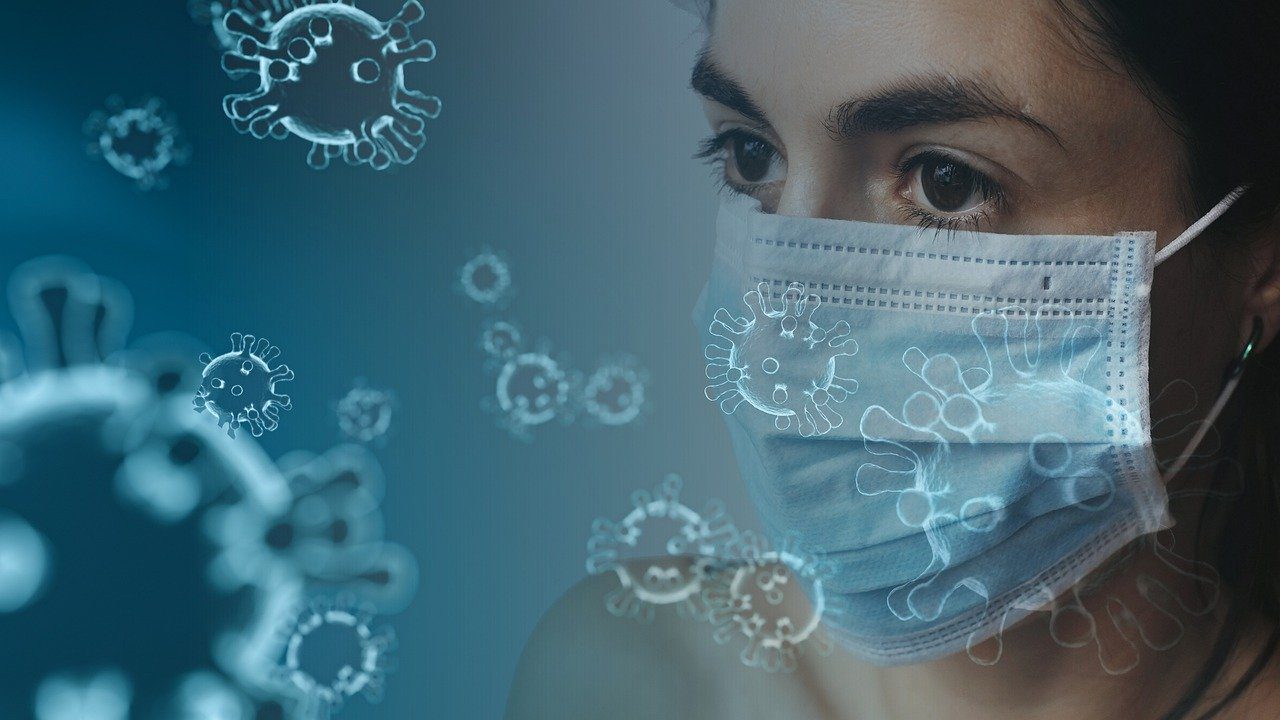HAMSILI PILAVDAN SIMITE – LAHMACUNDAN TEPSI KEBABINA KADAR EN SIHHATLI TURK YEMEGI TARIFLERI CNN DEN EVDE GECIRDIGIMIZ BU GUNLER ICIN YAPILMALARI TAVSIYESI ILE… AFIYET OLSUN
TURKISH FORUM – DUNYA TURKLERI BIRLIGI

TURKISH FORUM – DUNYA TURKLERI BIRLIGI

|
|
|
|
|
|
|
|
|
|
|
|
|
|
|
|
|
|
|
|

As the novel coronavirus sweeps across the United States, it appears to be infecting and killing black Americans at a disproportionately high rate, according to a Washington Post analysis of early data from jurisdictions across the country.
The emerging stark racial disparity led the surgeon general Tuesday to acknowledge in personal terms the increased risk for African Americans amid growing demands that public-health officials release more data on the race of those who are sick, hospitalized and dying of a contagion that has killed more than 12,000 people in the United States.
A Post analysis of available data and census demographics shows that counties that are majority-black have three times the rate of infections and almost six times the rate of deaths as counties where white residents are in the majority.
In Milwaukee County, home to Wisconsin’s largest city, African Americans account for about 70 percent of the dead but just 26 percent of the population. The disparity is similar in Louisiana, where 70 percent of the people who have died were black, although African Americans make up just 32 percent of the state’s population.
In Michigan, where the state’s 845 reported deaths outrank all but New York’s and New Jersey’s, African Americans account for 33 percent of cases and roughly 40 percent of deaths, despite comprising only 14 percent of the population. The state does not offer a breakdown of race by county or city, but more than a quarter of deaths occurred in Detroit, where African Americans make up 79 percent of the population.
And in Illinois, a disparity nearly identical to Michigan’s exists at the state level, but the picture becomes far starker when looking at data just from Chicago, where black residents have died at a rate six times that of white residents. Of the city’s 118 reported deaths, nearly 70 percent were black — a share 40 points greater than the percentage of African Americans living in Chicago.
[Sign up for our Coronavirus Updates newsletter to track the outbreak. All stories linked in the newsletter are free to access.]
| County majority | Counties | Cases per 100k | Deaths per 100k |
|---|---|---|---|
| Asian | 6 | 19.5 | .4 |
| Black | 131 | 137.5 | 6.3 |
| Hispanic | 124 | 27.2 | .6 |
| White | 2,879 | 39.8 | 1.1 |
President Trump publicly acknowledged for the first time the racial disparity at the White House task force briefing Tuesday.
“We are doing everything in our power to address this challenge, and it’s a tremendous challenge,” Trump said. “It’s terrible.” He added that Anthony S. Fauci, director of the National Institute of Allergy and Infectious Diseases, “is looking at it very strongly.”
“Why is it three or four times more so for the black community as opposed to other people?” Trump said. “It doesn’t make sense, and I don’t like it, and we are going to have statistics over the next probably two to three days.”
Detailed data on the race of coronavirus patients has been reported publicly in fewer than a dozen states and several more counties.
African Americans’ higher rates of diabetes, heart disease and lung disease are well-documented, and Louisiana Gov. John Bel Edwards (D) noted that those health problems make people more vulnerable to the new respiratory disease. But there never has been a pandemic that brought the disparities so vividly into focus.
The crisis is “shining a bright light on how unacceptable” those disparities are, Fauci said at the briefing. “There is nothing we can do about it right now except to try and give” African Americans “the best possible care to avoid complications.”
“I’ve shared myself personally that I have high blood pressure,” said Surgeon General Jerome Adams, who is 45, “that I have heart disease and spent a week in the [intensive care unit] due to a heart condition, that I actually have asthma and I’m prediabetic, and so I represent that legacy of growing up poor and black in America.”
Adams added, “It breaks my heart” to hear about higher covid-19 death rates in the black community, emphasizing that recommendations to stay at home to slow the spread are for everyone to follow.
On Monday, the Lawyers’ Committee for Civil Rights Under Law and hundreds of doctors joined a group of Democratic lawmakers, including Sens. Elizabeth Warren (Mass.), Cory Booker (N.J.) and Kamala D. Harris (Calif.), in demanding that the federal government release daily race and ethnicity data on coronavirus testing, patients and their health outcomes.
To date, the Centers for Disease Control and Prevention has only released figures by age and gender.
[Covid-19 is ravaging black communities. A Milwaukee neighborhood is figuring out how to fight back.]
Legislators, civic advocates and medical professionals say the information is needed to ensure that African Americans and other people of color have equal access to testing and treatment, and also to help to develop a public-health strategy to protect those who are more vulnerable.
In its letter to Health and Human Services Secretary Alex Azar, the Lawyers’ Committee said the Trump administration’s “alarming lack of transparency and data is preventing public health officials from understanding the full impact of this pandemic on Black communities and other communities of color.”
As pressure mounted, a CDC spokesman said Tuesday that the agency plans to include covid-19 hospitalizations by race and ethnicity in its next Morbidity and Mortality Weekly Report, more than six weeks after the first American died of the disease.
Health departments nationwide report coronavirus cases to the CDC using a standardized form that asks for a range of demographic information, including race and ethnicity. However, fields are often left blank and those local agencies are “under a tremendous amount of strain to collect and report case information,” said Scott Pauley, a CDC spokesman.
As the disease has spread in the United States, information on age, gender and county of residence also has been reported inconsistently and sporadically.
In some regions, lawmakers are pushing to fill the data gap on their own. Virginia reports the racial breakdown of its cases but not of its deaths. In neighboring Maryland, Gov. Larry Hogan (R) said Tuesday the state would begin to release data about race, a day after more than 80 members of the House of Delegates sent him a letter asking for the information.
Del. Nick Mosby, a Democrat who represents Baltimore, has pushed for the data for weeks after he started hearing from friends, colleagues and his Omega Psi Phi fraternity brothers about black men who were infected or were dying of covid-19.
“It was kind of frightening,” Mosby said. “I started receiving calls about people I knew personally.”
In Washington, D.C., this week, district officials released race data for the first time, showing that the disease has killed African Americans in disproportionately high numbers. Nearly 60 percent of the District’s 22 fatalities were black, but African Americans make up about 46 percent of the city’s population.
Like many other jurisdictions, the District’s health officials don’t know the race of many people who have tested positive. In an interview with MSNBC on Tuesday, Mayor Muriel E. Bowser (D) said that the city lacked race data on half of all positive cases but that the existing data was enough for her to be “very fearful of the impact that this virus is going to have disproportionately on African Americans in our country.”
“We know that underlying conditions, like hypertension and diabetes and heart disease, this virus is particularly hard on,” Bowser said. “And we know that African Americans are living with those underlying conditions every day, probably in larger proportions than most of our fellow Americans.”
Although the disparities have garnered national attention in recent days, some predominantly black communities have been rocked by the outbreak for the past several weeks — and not just in the nation’s urban cities.
Dougherty County and the city of Albany, in rural southwest Georgia, have recorded the highest number of deaths in Georgia. Dougherty, with a population of 90,000, had 973 positive cases and 56 deaths as of Tuesday.
By contrast, Fulton County, which includes Atlanta and has a population of more than 1 million, had 1,185 cases and 39 deaths. Black residents make up 70 percent of Dougherty’s population and more than 90 percent of coronavirus deaths, said county coroner Michel Fowler.
“Historically, when America catches a cold, black America catches pneumonia,” Albany City Commissioner Demetrius Young said last week.
Elected officials and public-health experts have pointed to generations of discrimination and distrust between black communities and the health-care system. African Americans are also more likely to be uninsured and live in communities with inadequate health-care facilities.
As a result, African Americans have historically been disproportionately diagnosed with chronic diseases such as asthma, hypertension and diabetes — underlying conditions that experts say make covid-19 more lethal.
Critics of the public-health response have cited confusing messaging about how the virus is transmitted, such as an early emphasis on overseas travel, and have noted that some public officials were slow to issue stay-at-home directives to encourage social distancing.
Even then, some activists argued, black people might have been more exposed because many held low-wage or essential jobs, such as food service, public transit and health care, that required them to continue to interact with the public.
“This outbreak is exposing the deep structural inequities that make communities pushed to the margins more vulnerable to health crises in good times and in bad,” Dorianne Mason, the director of health equity at the National Women’s Law Center, said in a statement. “These structural inequities in our health care system do not ignore racial and gender disparities — and neither should our response to this pandemic.”
David Montgomery, Ovetta Wiggins, Samantha Pell and Darran Simon contributed to this report.


The United States is now an epicenter of the coronavirus pandemic, with epidemiological models publicized on Tuesday suggesting the disease could infect millions of Americans in the coming months, killing between 100,000 and 240,000. Hospitals in the state of New York, where there are more than 75,000 confirmed cases, are already overwhelmed and experiencing shortages of critical medical equipment such as ventilators and protective gear. The grim projections indicate that the virus has not reached its peak and that the situation will get worse.
Amid the pandemic, U.S. President Donald Trump and other world leaders have faced criticism for their slow and ineffective response since it became clear that the coronavirus would not be contained to China, where it originated. Other countries such as Taiwan, Singapore, and South Korea have been heralded as relative success stories for flattening the curve before infection rates soared exponentially. As countries brace for a monthslong crisis, we’ve collected our top reads and interviews from recent weeks on how governments and citizens around the world have responded to the threat of COVID-19 so far.
Taiwan recorded its first case of the coronavirus on Jan. 21, but it has managed to keep its number of confirmed cases to just 329 with five deaths as of April 1. The country is effectively locked out of the World Health Organization (WHO), since membership is usually only accorded to countries that are members of the United Nations, which does not recognize Taiwan. But as Hilton Yip wrote on March 16, the government sprang into action as soon as news broke about a mysterious illness in Wuhan. Taiwan, which sits just 100 miles from mainland China, began inspecting travelers coming from the city on Dec. 31, set up a system to track those in self-quarantine, and ramped up production of medical equipment in January. (Taiwan has not yet resumed exports of the supplies, including surgical face masks.)
Yip attributed Taiwan’s early and effective response to past experience. “Given that Taiwan has faced everything from its giant neighbor—the spreading of fake news, military threats, the withholding of vital medical information during the SARS outbreak in 2003—the country knows it must be on its fullest guard whenever any major problem emerges in China,” he wrote.
[Mapping the Coronavirus Outbreak: Get daily updates on the pandemic and learn how it’s affecting countries around the world.]
South Korea, which had one of the largest initial outbreaks outside China, also managed to slow the spread of new coronavirus cases without instituting any lockdowns. Devi Sridhar argued on March 23 that the country’s exemplary model for mass diagnostic testing was the only way to contain the outbreak—and that other countries should look to East Asia for lessons. South Korea, which has a population of 51 million, tests more than 20,000 people daily at designated testing sites and uses isolation and widespread contact tracing to break chains of transmission—as recommended by WHO. “South Korea is showing how this model ultimately pays off in reducing spread, taking pressure off health services, and keeping its death rate one of the lowest in the world,” Sridhar wrote.
In the West, Canada managed to roll out more expansive testing than the neighboring United States, as Justin Ling wrote on March 13. In January and February, Canada began setting up the infrastructure to conduct tests and contact tracing. The early response in part came from the country’s experience during the SARS outbreak in 2003. (Then, Canada was the only country outside Asia to report deaths from the virus.) Canada has a well-funded public health care system, and its criteria for who can be tested for COVID-19 is not as limited as in the United States. “Canada has spent the past two decades preparing for this moment,” Ling wrote. “By catching cases early, and investigating their origins, Canada has blunted the impact of the virus thus far.”
Some success stories are unexpected. On the Don’t Touch Your Face podcast, Foreign Policy’s Amy Mackinnon singled out the early response of the country of Georgia. Despite its small size and struggling economy, the country began taking serious measures at the end of February, including closing schools and conducting widespread diagnostic tests. Georgia has so far confirmed 117 cases and no deaths from COVID-19. “I think the fact that the government took it seriously from the very start has helped,” the Georgian journalist Natalia Antelava told Mackinnon. So has Georgia’s mindset. “This is a country that is used to crisis, and it is a country that has lived through civil wars and the Russian invasion in 2008 and a very dark period through the ’90s after the collapse of the Soviet Union,” Antelava said.
Mackinnon also interviewed Jelena Ciric, a journalist in Iceland, which has one of the highest per capita rates of confirmed coronavirus cases. That’s because it has also tested more people per capita than anywhere else in the world—an effort led by a private medical research company based in Reykjavik. The research will be used to inform the global response to the pandemic. “What that gives us in Iceland is somewhat of a clearer picture of how the virus is spreading through the general population,” Ciric said. “Our growth has not actually become exponential due to these early measures of quarantining people who have likely been exposed to the virus.”
Elsewhere, citizens are not so trusting of their governments’ expertise. In Russia, daily life continued as normal until mid-March, when medical experts began questioning official statistics showing a low rate of COVID-19 infection. The government moved quickly to close the borders and announce a large economic stimulus plan, wrote Foreign Policy’s Reid Standish, reporting from Moscow. “Should the true scope of the virus prove to be higher than shown in official statistics, it would mean that the Russian government has missed its chance to slow the pandemic,” he wrote. Two weeks later, it appears that the coronavirus could present a serious political challenge for President Vladimir Putin, as Standish reported on March 30.
There is also significant doubt about the statistics in Iran, which officially reports 47,593 coronavirus cases and 3,036 deaths as of April 1. The real figures are almost certainly much higher—making Iran a coronavirus epicenter, Maysam Behravesh argues. As cases climbed in China in January, Iranian officials didn’t restrict travel between the countries and apparently delayed announcing an outbreak in the religious city of Qom until after the first COVID-19 deaths. Many high-ranking figures have since died from the virus. Behravesh attributes Iran’s failed response in part to misunderstanding.
“Iran’s general neglect of the colossal public health threat posed by the coronavirus also emanates from its fundamental unfamiliarity with the nature of such a peril,” he writes. “After all, the virus isn’t a domestic revolt or foreign intervention aimed at regime change, but a creeping, invisible menace against the whole society that requires a science-centered response.”

COVID-19, Essential info from
Johns Hopkins Hospital..
Essential info from JOHNS HOPKINS HOSPITAL – Stop being afraid
As there is so much information and misinformation, I hope this will help to clarify some issues and make you safer. Jana
The following is from Irene Ken physician, whose daughter is an Asst. Prof in infectious diseases at Johns Hopkins University, quite informative.
* The virus is not a living organism, but a protein molecule (DNA) covered by a protective layer of lipid (fat), which, when absorbed by the cells of the ocular, nasal or buccal mucosa, changes their genetic code. (mutation) and convert them into aggressor and multiplier cells.
* Since the virus is not a living organism but a protein molecule, it is not killed, but decays on its own. The disintegration time depends on the temperature, humidity and type of material where it lies.
* The virus is very fragile; the only thing that protects it is a thin outer layer of fat. That is why any soap or detergent is the best remedy, because the foam CUTS the FAT (that is why you have to rub so much: for 20 seconds or more, to make a lot of foam).
By dissolving the fat layer, the protein molecule disperses and breaks down on its own.
* HEAT melts fat; this is why it is so good to use water above 25 degrees Celsius for washing hands, clothes and everything. In addition, hot water makes more foam and that makes it even more useful.
* Alcohol or any mixture with alcohol over 65% DISSOLVES ANY FAT, especially the external lipid layer of the virus.
* Any mix with 1 part bleach and 5 parts water directly dissolves the protein, breaks it down from the inside.
* Oxygenated water helps long after soap, alcohol and chlorine, because peroxide dissolves the virus protein, but you have to use it pure and it hurts your skin.
* NO BACTERICIDE OR ANTIBIOTIC SERVES. The virus is not a living organism like bacteria; antibodies cannot kill what is not alive.
* NEVER shake used or unused clothing, sheets or cloth. While it is glued to a porous surface, it is very inert and disintegrates only -between 3 hours (fabric and porous),
-4 hours (copper and wood)
-24 hours (cardboard),
– 42 hours (metal) and
-72 hours (plastic).
But if you shake it or use a feather duster, the virus molecules float in the air for up to 3 hours, and can lodge in your nose.
* The virus molecules remain very stable in external cold, or artificial as air conditioners in houses and cars.
They also need moisture to stay stable, and especially darkness. Therefore, dehumidified, dry, warm and bright environments will degrade it faster.
* UV LIGHT on any object that may contain it breaks down the virus protein. For example, to disinfect and reuse a mask is perfect. Be careful, it also breaks down collagen (which is protein) in the skin.
* The virus CANNOT go through healthy skin.
* Vinegar is NOT useful because it does not break down the protective layer of fat.
* NO SPIRITS, NOR VODKA, serve. The strongest vodka is 40% alcohol, and you need 65%.
* LISTERINE IF IT SERVES! It is 65% alcohol.
* The more confined the space, the more concentration of the virus there can be. The more open or naturally ventilated, the less.
* You have to wash your hands before and after touching mucosa, food, locks, knobs, switches, remote control, cell phone, watches, computers, desks, TV, etc. And when using the bathroom.
* You have to HUMIDIFY HANDS DRY from so much washing them, because the molecules can hide in the micro cracks. The thicker the moisturizer, the better.
* Also keep your NAILS SHORT so that the virus does not hide there.
JOHNS HOPKINS HOSPITAL